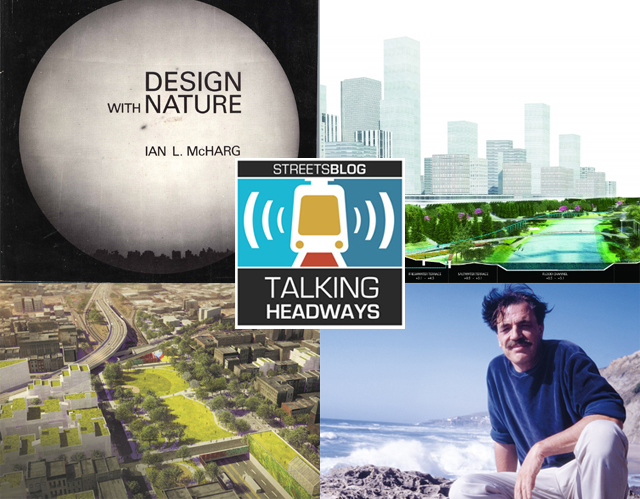Talking Headways Podcast: Ian McHarg and ‘Design with Nature Now’
8:42 AM EDT on August 20, 2020

This week, we’re joined by Billy Fleming, who is the Wilks Family Director of the University of Pennsylvania’s McHarg Center, to talk about the center’s book, Design with Nature Now. We chat about Ian McHarg’s influence and legacy since the original Design with Nature, the influence of his work on GIS and the environmental movement, and how the Center seeks to find where design fits into the larger discussion of human life and policy like the Green New Deal.
For those of you who prefer to read rather than listen, a transcript of the highlights follows the audio player below. The full, unedited transcript can be read here:
Jeff Wood: So who was Ian McHarg?
Billy Fleming: Yeah, so Ian was kind of a wild guy who was a Scottish paratrooper or during World War II. He had been brought up just outside of Glasgow in the Clyde River Valley. He had not graduated from college or, if I remember correctly, maybe he didn't actually finish high school. But he sort of famously wrote a letter to Harvard's faculty letting them know you would like to come there to study and to make accommodations for him. I think that stories been a little exaggerated over the years — I think there was probably a formal application, probably a formal acceptance, but that's kind of the mythology of him.
And, you know, you can train as architects under some of the biggest name Modernists of his day. And in some ways he sort of reacted to that training at Harvard and the sort of school of Modernism that was there at the time. He tried to ask different questions about how people relate to nature and nature relates to people. And so shortly after he finished as at Harvard, he was hired here to reconstitute the landscape architecture department at Penn, which had been defunct for quite awhile, that this is in the mid 1950s.
And his first task is to really start putting together an interdisciplinary group of faculty. So he's pulling people, not just from landscape architecture and architecture and planning, but also from art and social sciences and humanities. You know, geologists, geographers, anthropologists, artists, all kinds of folks together as standing faculty in the department and over time building up this theory or framework of Design With Nature that he publishes in 1969. It's about all kinds of things, but it's ultimately built around what he would call his sort of "ecological method," which is about layering biophysical and geological and ecological information together. ... That became his method for thinking about how design operates in the built, the natural environment. It's through the layering of a technocratic and scientific information, with an idea that it would kind of reveal where and how to intervene in those places.
JW: You mentioned GIS. I'm curious how much his work influenced, what we know now is GIS and it seems to be pretty substantial.
BF: Yeah. I mean, I hesitate to say that they're would not be GIS without Ian McHarg because he ultimately placed his software bet in a different company that didn't work out than ESRI. But he and his students and some of their colleagues at Harvard and a few other places were really instrumental in the creation of GIS as a set of software that help us analyze and understand at least the surface of the planet. Some of those students and collaborators at a time, included folks like Paul Steinitz, who's really one of the forefathers with Geo Design. I don't think its hyperbolic to say there would probably not be GIS is we know it today without Ian and the interdisciplinary group of faculty and students that he put together here, a half century or so ago, one of whom is a founder of ESRI which is Jack Dangermond.
~~~
JW: You know, there's a piece in Scientific American recently talking about how sometimes our goals in one area and get in the way of our goals in another. Housing policy can be damaged if we create environmental policies that hurt the poor or, or transport policies that hurt the environment, even if in the silo, they seem beneficial. I'm wondering how we kind of reconcile that idea of stepping on each other's toes with this creation of a Green New Deal. You mentioned that previously, and I'm curious if your thoughts, generally, of a Green New Deal, just because it's a buzzword right now, but what does it actually mean and how do we get to a point where we're actually affecting how we're impacted by climate change?
BF: I think the thing that about the Green New Deal that it offers that is unique is that it is directly tailored to sort of addressing that tension or that question that you foregrounded. So from the previous iterations of national climate policy that have come forward have tended the fall into maybe one or two of three buckets. One being sort of really science-based technocratic policy. So it was focused on emissions reduction say on de-carbonization only as kind of a technological fix solution. Or its been focused purely on say environmental justice concerns. It might be investments in labor or it might be investments in brownfield cleanups, might be investments in public housing and public school abatement, all the asbestos and lead that fill some of those buildings up.
Or it might've been focused on say like green jobs, the economy, and sort of building up the solar, wind, battery sectors of the economy.
And what the Green New Deal has really innovated is not necessarily coming up with a bunch of new components, but in fusing those things together. And so as a frame work it really is the first one to kind of fuse those sorts of legacy Green demands with this sort of union and blue collar worker demands with sort of frontline community and justice and EJ-related demands into a coherent singular sort of climate policy framework.
And that necessarily means, it's like big and sprawling and messy at times. And you know, we're only really about a year and a half into the introduction of HR 109, which was the kind of public announcement of what the green new deal is. And here's how we think that might actually become a set of laws and a set of practices that amount to something like a GND the way that, you know, set up a legislation. So several pieces of legislation, several new agencies, several new things, constituted the New Deal rather than a sort of single piece of legislation.
And so I think the Green New Deal really like lives at the moment in both that resolution and in, for better or worse, some of the state climate policy plans that are out there and some of which have been implemented like New York State's and in Joe Biden's sort of campaign platform, which imperfect as it is, is probably the most-ambitious climate platform ever put forward by a major party nominee.
And it's in large part because of the introduction of the GND, and the sustained pressure from movement leaders in that interceding period to hold him accountable to the demands put forward in that resolution.
Jeff Wood is the creator of the Talking Headways podcast and editor of the newsletter The Overhead Wire.
Stay in touch
Sign up for our free newsletter
More from Streetsblog USA
Tuesday’s Headlines Fix It First
How voters incentivize politicians to ignore infrastructure upkeep. Plus, are hydrogen trains the future of rail or a shiny distraction?
Why We Can’t End Violence on Transit With More Police
Are more cops the answer to violence against transit workers, or is it only driving societal tensions that make attacks more frequent?
Justice Dept., Citing Streetsblog Reporting, Threatens to Sue NYPD Over Cops’ Sidewalk Parking
The city is now facing a major civil rights suit from the Biden Administration if it doesn't eliminate illegal parking by cops and other city workers.
Five Car Culture Euphemisms We Need To Stop Using
How does everyday language hide the real impact of building a world that functionally requires everyone to drive?




